Being immersed in the fitness industry provides me with a ton of different opportunities to experience different techniques, methodologies, and products. I recently had the privilege of a...


Being immersed in the fitness industry provides me with a ton of different opportunities to experience different techniques, methodologies, and products. I recently had the privilege of a...
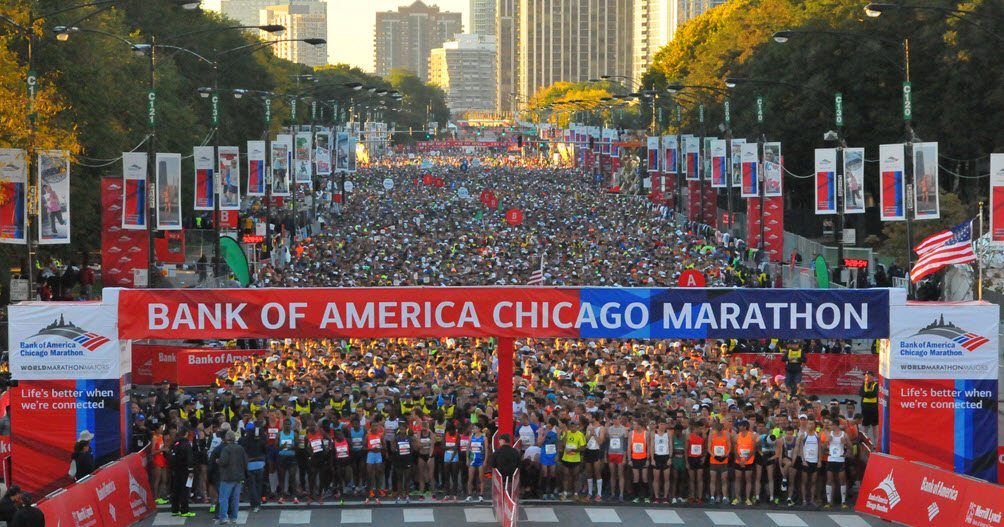
Leading up to the Chicago Marathon 2016 The Chicago Marathon provides an excellent course, plenty of support and, for me, a chance to visit home for a few days. It was no different for me this...
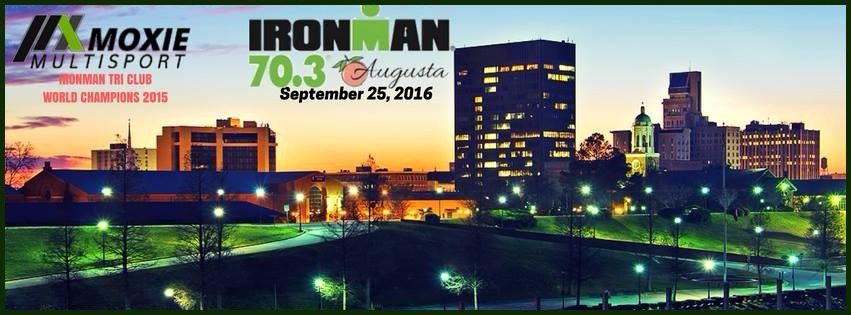
September 25 was going to be my day. The Ironman Augusta 70.3 triathlon was finally here. The race I had been training so hard for on one of my favorite courses. It was four-and-a-half months...
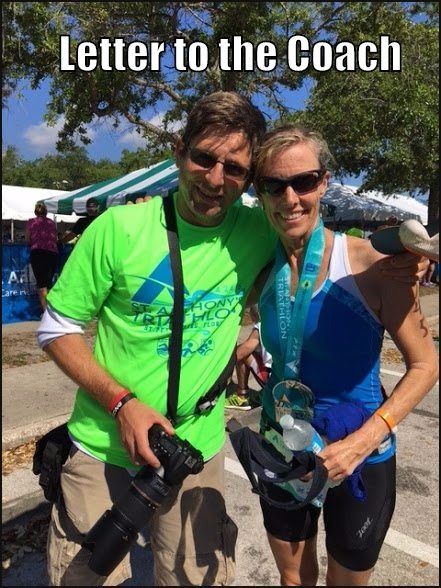
I have been an endurance coach for some time now. Once in a while, I receive an email from a client which chokes me up with pride. Today, I received one of those letters, so instead of sharing it...
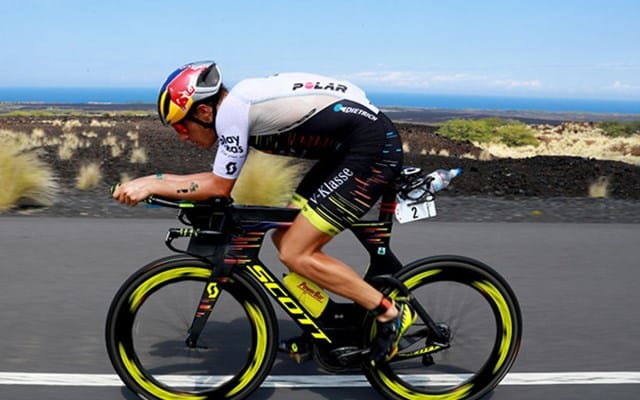
I found when looking for ways to get faster on the bike, is that there is so much information, from different coaches and experts, that it can be confusing and overwhelming. Personally, I...
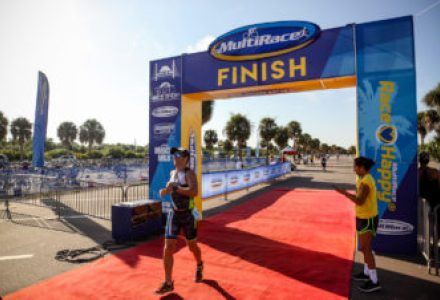
The previous post was a review of the FD3 Triathlon Series as if it was a product. Below you will find a more detailed account of my personal experiences during the race. Let me know in the...

September 25 was going to be my day. The Ironman Augusta 70.3 triathlon was finally here. The race I had been training so hard for on one of my favorite courses. It was four-and-a-half months since Ironman Chattanooga 70.3 and I was going to be ready to get my vindication and PR like I never had before. This was going to be my glory day. I knew it.
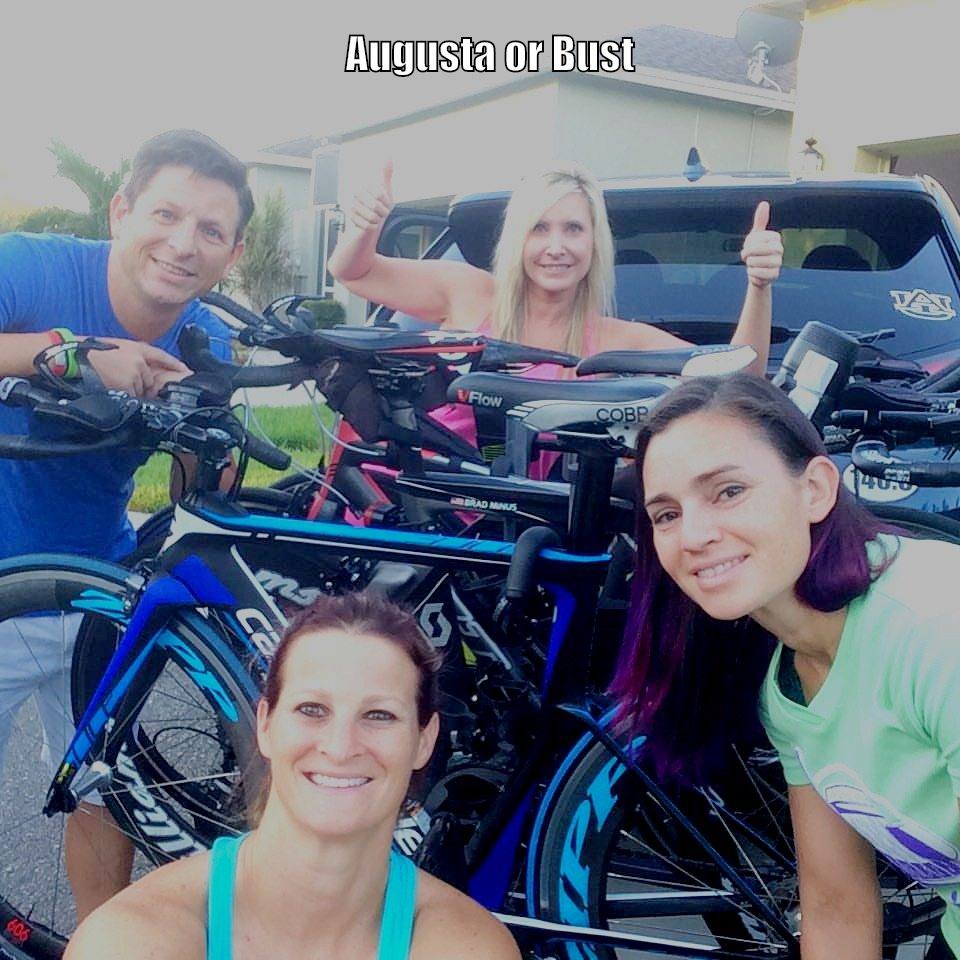
Driving up from Tampa, was a piece of cake. I had the presence of some beautiful and talented athletes; Maria Lopez Vijayanagar, Nancy Hepner, and our own personal driver, Jamie Breibart. Between awesome conversations, laughing and completing some work, the time flew by. Before we knew it, we were pulling up to the Marriott Hotel which housed the Augusta Convention center.
This was the first time ever, I stayed in the Ironman Augusta 70.3 host hotel. Actually, it was the first time I ever stayed in a race’s host hotel and I was excited.
The pounding of my pulse intensified with every step we took towards the expo. Check-in was a breeze especially on Friday afternoon since most of the athletes would probably wait until Saturday. The next thing I knew, I had my cool new swim bag containing my packet, t-shirt, and swag. A few moments later, I was standing in line to buy the traditional extras. Some athletes always get that year’s t-shirt, some pick something different every time, I get a coffee mug and water bottle with the race logo.
The vendors that provided booths were of the same variety as usual. Cliff bars, a local gear shop, BASE salts, a new pet food sponsor, and of course my friend Scott Rigsby with his foundation.
I have mentioned Scott in a few other posts. He was the first double amputee to finish the Kona World Championship Ironman. He went on to form a foundation to help soldiers with disabilities; The Scott Rigsby Foundation.
With that completed, we headed down to Mellow Mushroom for some much-deserved carbs to include one of our favorite carbohydrates. BEER. Craft Beer because I am a snob like that. If you ever get to try their Mega-Veggie pizza, go for it. It is magnificent, especially if the tofu is traded out for avocado.
After a long conversation at the bar that included my last drink before the race, it was time to get a good night sleep.
That, unfortunately, didn’t happen. Two nights prior I always prescribe a good nights sleep and only awake when the body is ready. This allows for maximal recovery for race day with ample healing of any inflammation.
I have no idea why. but sleep evaded me most of the night. I still felt rested upon getting out of bed around 7 am, but not as much as I would have liked.
It was a toss-up of whether to go and jump in the river with our wetsuits or not. Nancy had never swum in open water with a wetsuit and was nervous about the swim. I was also anxious to jump in to get a feel for the temperature and if my wetsuit was still functioning properly, so we headed down to the swim start.
We suited up and jumped in. The temperature was a little chilly at first, but within ten strokes it felt glorious. The current was running about 2 knots, so my strokes to the first buoy felt like slicing through butter.
Jaime and I waited at the first buoy while Nancy caught up to us. Her boyfriend Hans had arrived the night before and being a marathon swimmer, he was incredibly comfortable in the water. He talked her through jumping in and they met us at the buoy.
We splashed around and played like kids for a few minutes before we decided to head back. Now that was work. It was like swimming on a treadmill. We ended up swimming to the side and shimming up the dock instead. Funny thing was there was no way to use your legs to get on the floating dock. I muscled myself up and then brought up Jamie, Hans and finally Nancy. That was an experience.
To make matters worse there was a locked gate in front of us with nothing on either side except water. We had to carefully hang on the outer chain link fence to get around the locked gate door. It was like a pre-70.3 obstacle course.
With Nancy now comforted with the buoyancy of her wetsuit, and a real confidence booster for myself, we headed back to the hotel to get a quick ride in.
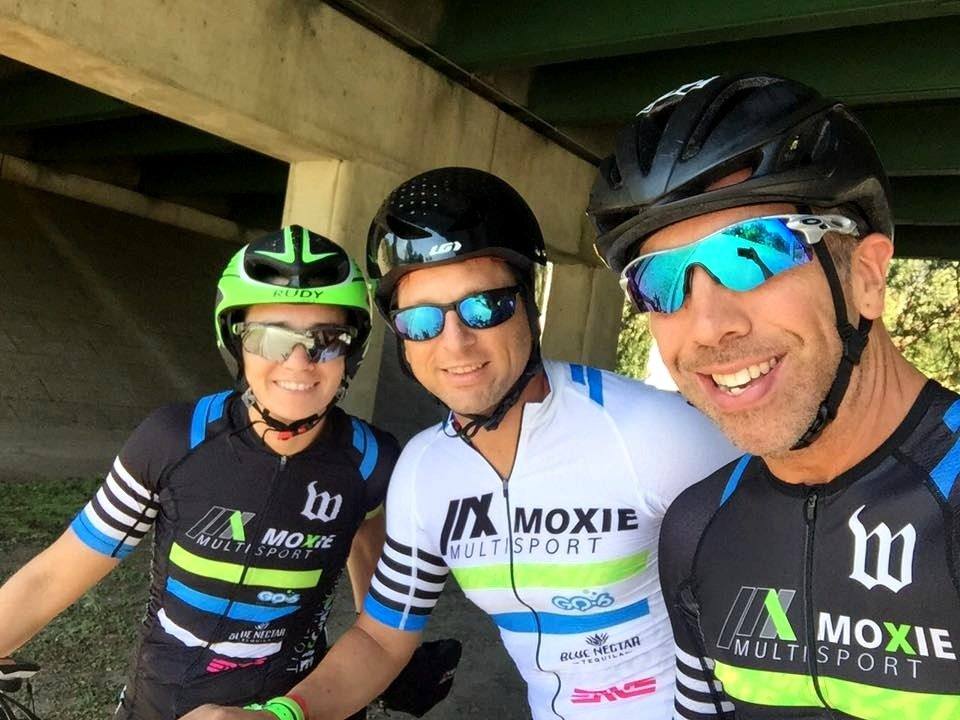
Maria and I headed out and on Broad St for about a mile when I heard Oscar Alvarez, a teammate from our national team Moxie Multisport, yell from the Holiday Inn. I have never had the chance to ride or even get to know Oscar so I was excited when he flagged us down. Donna Adams also joined us, from Moxie, as we headed out of town for about 15 minutes. We turned around and headed back.
I toggled through all my gears to include my small chainring knowing that there were some new hills added to the course. Everything seemed to work very smoothly, which just increased the intensity my excitement.
After dropping off Oscar and Donna at their hotels, Maria and I pedaled back to pick up Nancy and Jamie. I completed attaching the stickers on my bike and changed into regular shoes for the jog back. I, unintentionally, put my debit card and license in a bento box on my bike, and we headed out.
Again, things went very smoothly. We rode right in, racked our bikes and headed out. I had a pretty good position sitting almost the very middle of the transition area, just a few positions to the left of the aisle.
It didn’t seem like anyone wanted to jog back, and I was ok with that. However, about half-a-mile out, I remembered that I had my credit card and license on my bike. I gave my helmet to the ladies while telling them I would catch up and I started running back to transition.
This is the first season in seven-and-a-half years I have had any type of injuries. Earlier in the year, I was suffering from a stress reaction in one of my right metatarsals and lately, I had been suffering from some Achilles tendinitis. It was so wonderful to run and not feel any of that pain.
Running into transition I caught the site of April from my local team, Outspokin Multisport. I stopped and chatted for a quick second before continuing on to rescue my stuff. Confidently, I ran back out feeling really strong. I was lucky to run into two more Moxie teammates, Josh Otstot and Alex Bautista before finally catching up to Maria and Jaime.
The confidence was brimming with me throughout dinner at a local sushi and hibachi restaurant. I had rice, chicken and little sushi to fulfill my balance of carbs, protein, and good fats.
Fueled and completely prepped for the race, I fell asleep and remained in restful slumber until the alarms went off at 4:00 am.
Ironman rotates the start waves of their races, in order be fair to all of the Age Groups. In other words, while one year the 45-49 age group might be in an earlier wave, the following year that same group would be scheduled later. This year my age group was starting later at 8:28 am.
Since we didn’t need to travel to transition to setup race-ready, we dressed comfortably and headed out to the buses to be transported to the transition site.
Over the years, my experience in setting up my transition has been drastically reduced. I now can do a full setup and walk-through in just a few minutes where before it would take a lot longer. As I started placing bottles in the cages I noticed my rear tire was completely flat.
While a lot of athletes would consider this bad luck, I was grateful that I found it now rather than on the course. Not to mention, there was a maintenance crew here that would be far faster at repairing it than I would.
As it turned out, I was correct in that assumption. I handed the mechanic a tube, and they pulled my back wheel, changed the tube to include adding an extender, returned the wheel to my bike all within just a few minutes. With that, I was set up and ready to rock n’ roll.
Announcements flooded the air during our setup time in transition, of which most were normal except for the one big kicker.
“We are making history today. For the first time in Ironman Augusta history the swim will be not wet suit legal for age group awards.”
This was a little bit of a surprise. This was one of the reasons I loved this race. I am not the fastest swimmer but allow me a downstream swim in a wetsuit and I can hold my own. Unfortunately, now I just lost one of my advantages.
All the way back to the hotel, I took part in a lot of self-talk. Telling myself, that I had done the distance in the pool hundreds of times, and as the river was fresh water that is all this was. I also still had the advantage of the current which was moving between 1.5 and 2 knots. Not to mention, my transition time should be faster.
This calmed me down, as we headed back up to the room to prepare for our start times.
My breakfast of oatmeal, a banana, a cliff bar, and coffee went down easily as my anxiety slowly started to grow. I rolled out my legs, did some dynamic stretching, dressed, and headed over to Jaime’s room to pass the time before heading down to the swim start.
At 7:30 we walked down to the swim start as Nancy had an 8:04 start time, followed by me at 8:28, and Jaime at 8:40. As this would be Maria’s last race in the Pro division, she was already on the course.
I was pushing all of my positive energy to the forefront of my mind for Nancy. She was comfortable in the water during our test swim the previous day and while she could’ve still used her wetsuit, it would have meant starting at 9:30. With the temp already at 77 degrees that would have been for an even hotter race. I applauded her for deciding to go without and starting with her wave.
Before I knew it I gave hugs to Jaime, a number of other friends and teammates, and was in line with the rest of my age group.
At 8:24 the staff moved us to the dock where we would start. Usually, there is a rope start-line ten or so meters from the dock. This year they wanted us to start touching the dock. Due to the number of triathletes in my group, there was not enough dock to allow everyone a water start, so I was forced to stand on the dock and jump in when the horn blew at 8:28.
As I jumped in, the cool water prickled my skin as I surfaced and started my stroke. The anxiety completely wore off, and my heart rate decreased when I found my rhythm. I kept my mind quiet, focusing on reaching as far as I could while driving my hip down pulling myself through the water like a ladder.
I have written and said before, I am not the fastest swimmer by far. Actually, I am downright slow, but I have been working on it every season. You can imagine my surprise when I reached and found a foot there. I couldn’t believe it either, I caught someone. There truly is a first time for everything.
As I was maneuvering around the swimmer and was surprised again by a kick to my hand. Then I was boxed in a group and I thought, “This is great, I can just hang in here and take advantage of the draft.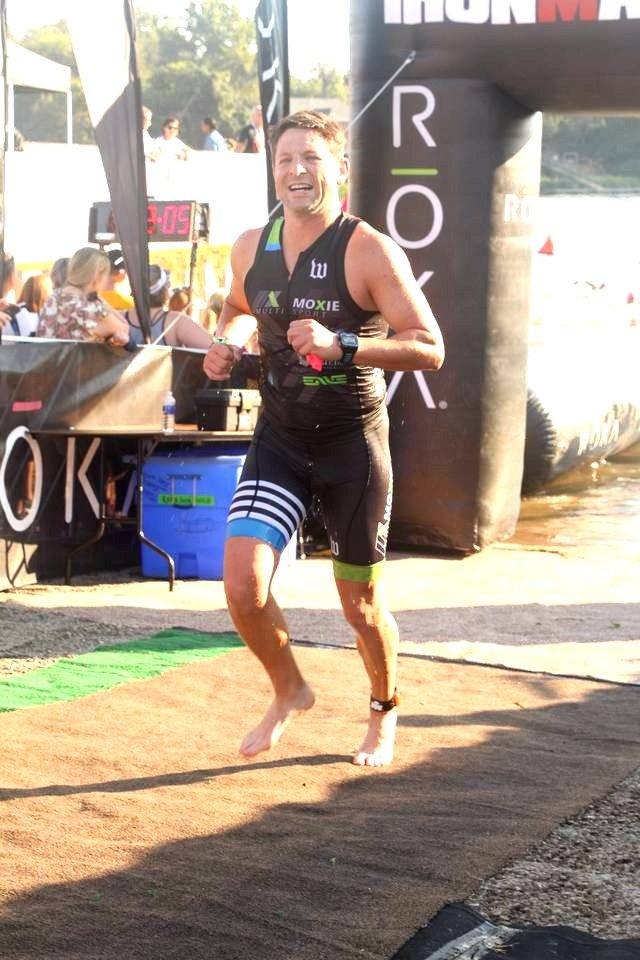 ”
”
Unfortunately, that didn’t last. The athletes on either side of me started swimming into me, throwing off my rhythm and the athletes in front slowed down so I was now getting kicked in the head.
I pulled back into a breaststroke and swam out of the way. It took a minute or so to get my breath and site line back so I could find my rhythm again.
Unfortunately, I experienced a similar scenario a little while later, with me resolving it in the same fashion. I was feeling a little peeved, but on the other hand, I was fascinated that I was forced to pass some of my fellow age group athletes in my weakest event.
With a huge smile on my face, I pulled off my cap and goggles as I ran into transition. I looked down at my watch and saw 34 minutes and change. That was a PR for me, not by much, but gave me a huge energy boost crossing the mount line as I began the bike portion.
This season was all about the bike. I have been focused on increased efficiency and speed on the bike during my training and my earlier results have proved that it had worked.
My ride felt like silk on the early portion of the bike. The derailleur was moving through my gear changes like butter, my goal power was ranging perfectly between 180 and 190 watts and my speed was a consistent 22 mile per hour. I felt like I was unstoppable.
The first set of hills uneventfully came and went without any kind of changes in effort level. The excitement was radiating from me because everything seemed to be coming together. I stuck to my nutrition plan and wattage like glue and just kept passing people.
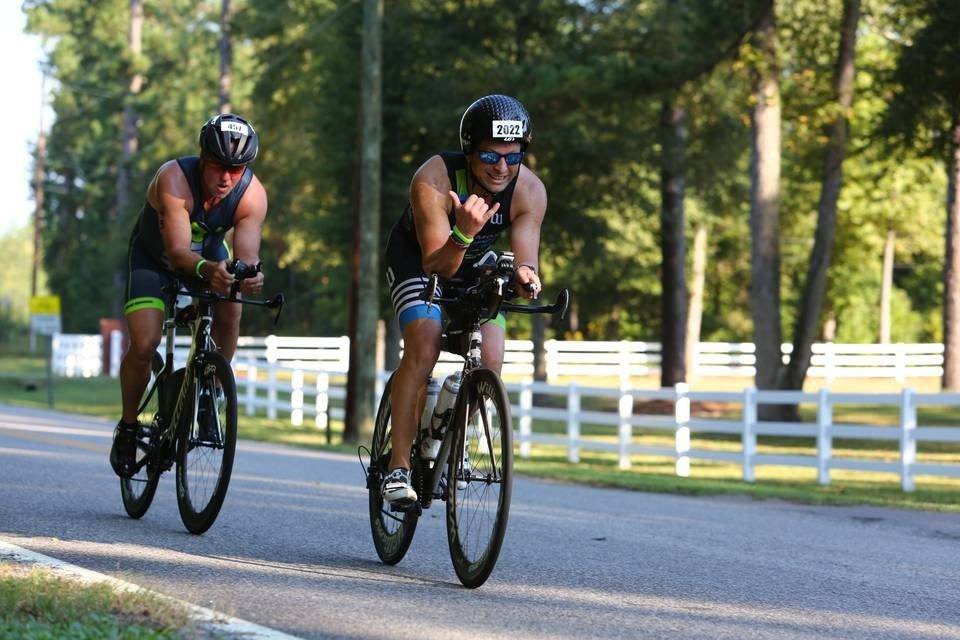 Another set of inclines came around mile 38. These were the grade of hills that bring your speed down to 9 miles an hour. I kept a cool head knowing that what goes up, must come down and I would make up the speed on the decline.
Another set of inclines came around mile 38. These were the grade of hills that bring your speed down to 9 miles an hour. I kept a cool head knowing that what goes up, must come down and I would make up the speed on the decline.
At mile 42, I noticed my time. Big Mistake. All of the sudden I was concerned that I was under 21 miles an hour of which I was consistent for the ride prior. Had I really slowed down that much? My goal was 21 mph, and I was thinking it was conservative. It would allow me to finish the bike in 2:39, but now that goal was in danger.
Around mile 45, I started to feel a little sluggish, so I took an extra gel and finished the formula in the current reservoir. Unfortunately, it took awhile for my digestive system to process the extra calories, as the following five miles felt very slow.
The last five miles were either downhill or pretty flat. I was consistently riding between 22 and 23 MPH, but it wasn’t enough. I rolled into T-2 in 2:48.
Just prior to the dismount line, my thoughts went to the run. I had decided I just needed to pick-up the pace 15-20 seconds for a few of the miles and I might just be able to make a lot of it up. Even if I didn’t hit my goal of 5:17, I would still PR.
I was ready to hit the dismount line running into T-2, but when swung my leg over my seat a pain in my hip almost made me fall. “What the hell?” were the words that came out of my mouth for everyone to hear.
I tried to run my bike into T-2, but they would not move. My legs just refused to do anything other than walk. My thoughts drifted to other races and my internal dialogue was encouraging reflecting my previous history of my legs waiting to transition at mile 3.
I changed my shoes, grabbed my race belt and hat and headed out, with a brief stop at the portlet. I tried to jog a little, but a stabbing pain was radiating both hips, so I walked very briskly. No problem, I strategized taking in a little more salt, some water and jogging to mile 3 where my legs would magically open up and I would finish around 2 hours. The goal not reached but still a PR.
Unfortunately, it never happened. Mile 3 came and went with me running slowly for a tenth to a quarter mile before having to walk. The pain radiating through my legs while running, but disappearing while walking.
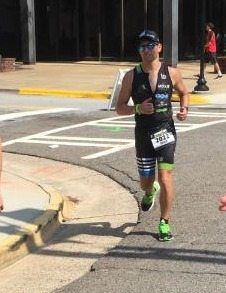 I went back to my training. Asking myself what I thought was happening physiologically. Tracing the muscles radiating from the hips, and assessing each individual pathway. I was at a complete loss. I had no idea what was going on.
I went back to my training. Asking myself what I thought was happening physiologically. Tracing the muscles radiating from the hips, and assessing each individual pathway. I was at a complete loss. I had no idea what was going on.
Over the next few miles, I did everything possible to go from aid station to aid station stuffing ice down my shorts trying to numb my hips. Unfortunately, the temperature and humidity were increasing as well. I didn’t feel like it was really that warm, but I noticed all the walkers.
The last four times I did this race, there were finishers that walked, but I didn’t recall the immense number of walkers I was noticing. There were more athletes walking than running. It didn’t make me feel any better, but there was definitely something going on.
The first time I completed Augusta I recall it being even hotter, but not nearly the amount of walkers I was noticing this year.
The rest of the run was more of the same. a quarter to a half mile of running and then I walked until the pain subsided. I was constantly making deals with myself to run just a little longer each time.
After 2 hours, mile 10 was the marker I was finally able to surpass feeling completely defeated, angry, in pain and embarrassed. I was doubting everything I ever learned, my ability as an athlete and as a coach. If I couldn’t get through a 70.3 in less than 6 hours what right did I have to coach other people?
When I finally turned the corner towards the finish line, Maria, Jaime, and Hans all had their cameras or phones out. I was trying to signal to them not to take a pic because I felt so ashamed.
Crossing the finish line was completely anti-climactic as my watch blinked 6:16. The slowest time since my first 70.3. I didn’t care about it and I almost passed up the people handing out the medals. At the time I am writing this I still have not hung the medal on my wall with the others.
I grabbed a coke from the food tent and proceeded to find Jaime, Maria, and Hans. We watched Nancy run by just prior to the halfway point, cheering her on and encouraging her to keep moving forward.
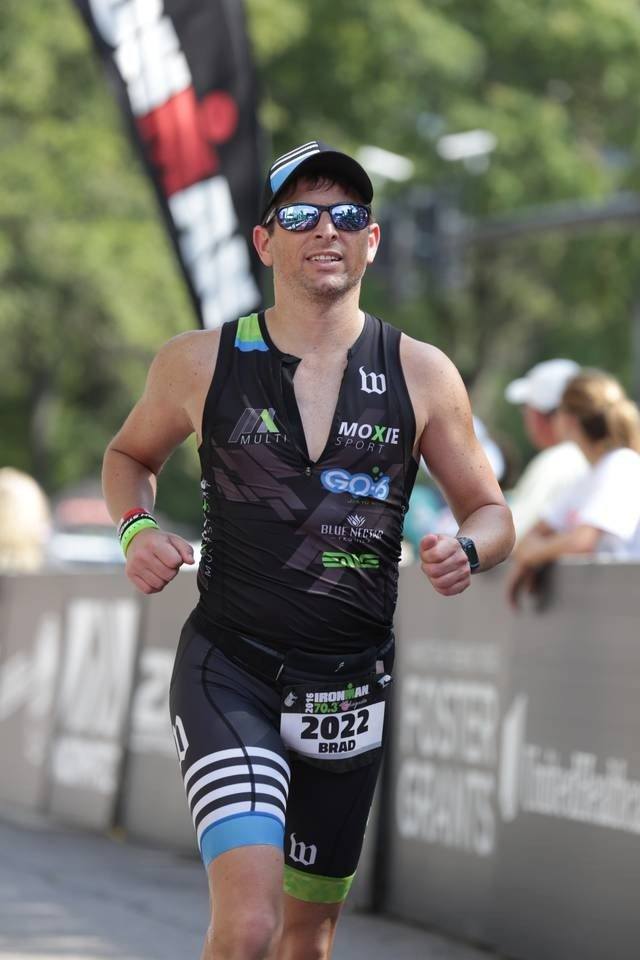 After that, I followed Maria back to the hotel and we chatted. She expressed her disappointment with her race, especially the run. I tried to be upbeat, but my thoughts were very negative. I really don’t like being that way. It makes me feel weak.
After that, I followed Maria back to the hotel and we chatted. She expressed her disappointment with her race, especially the run. I tried to be upbeat, but my thoughts were very negative. I really don’t like being that way. It makes me feel weak.
I left the celebration early that night and went back to the room. I packed and escaped into the mindless abyss of television just wanting the day to be over.
Over the next days, I reviewed the race, trying to resolve my issues on the run. I realized there is one crucial element of my training that I neglected this season. Massage.
In the past, my regimen included regular visits to my License Massage Therapist. That habit has been occurring for every season of training for five years prior. I completely neglected this avenue of my training this season. Was this the answer? I have no idea, but I will be taking that lesson and integrating back into my routine.
The release of negativity was a relief since returning home. My coach, Jon Noland, always says the best thing an athlete can have is a short-term memory. I have taken the lessons from this race, and now I am moving on to my next challenge.
CARPE VITAM!

I have been an endurance coach for some time now. Once in a while, I receive an email from a client which chokes me up with pride. Today, I received one of those letters, so instead of sharing it via a Facebook post, I decided to copy it here.
“Hello, Brad,
To reflect for a moment – It’s been about a year that you’ve been my coach. I have learned so much more than I ever would from a book, hanging out with colleagues, or trying to figure it out by myself. When I met you, I had been trying for years to run past 3 miles and frequently injured myself — I could never get past 3 miles was super frustrated, hated running, and I was very slow. In fact, none of my times in any of the sports were improving. After a couple of months working with you on form and technique, I tripled the number of miles I could easily run, I increased my speed and had absolutely no injuries. You have inspired me to try things I would never consider trying, regularly pushing me out of my comfort zone and helping me accomplish things I didn’t think were possible or I would ever have the guts to do (e.g., swim in cold water– you have no idea what a big deal that is– running a 10K, and riding in bike groups).
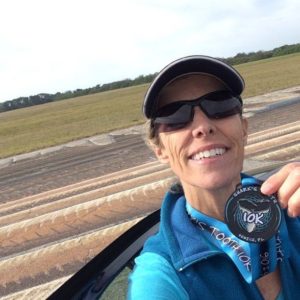
I felt like I couldn’t find anyone that would be interested in coaching me as an age grouper and being new to triathlon. Finding you was such a blessing because I feel like you treat me like a pro– you respect me for where I am, what I am trying to accomplish, and my repetitive silly questions (e.g. What is “PR?”). Your positive attitude is contagious and inspiring.
Everything you have taught me has been instrumental in reaching my triathlon goals and even helping me win the FD3 Series in my age group! That’s pretty cool! You’ve also worked around my schedule and needs to perfectly tailor the perfect program for me as an individual and because of that, I’ve gained improvement in running, swimming, and biking. I’m really grateful you don’t just prescribe a “one size fits all” approach– you related it to my personal needs.
I look so forward to our weekly calls, and knowing that someone is there holding me accountable, there to support me when I’m feeling discouraged, and perhaps more importantly, there to celebrate every success, no matter how big or small! It makes my day when I get random emails commenting on some aspect of my training. I can’t even begin to summarize how much I’ve learned from you. I’m constantly impressed by how well-informed and experienced you are– no matter how random I think my question might be, you always have an answer that is backed up by facts/literature/experience, etc.. Even when some random muscle hurts, your solutions have always worked!
I’m also thankful that you include the nutritional elements since that is a critical part of training and performa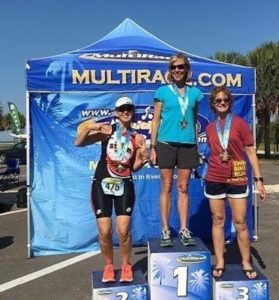 nce, as I’m slowly learning and trying to get better at communicating.. I had no idea how important all of this was.
nce, as I’m slowly learning and trying to get better at communicating.. I had no idea how important all of this was.
So, in about 8-10 months of working with you, I’ve tripled my running distance, increased my run pace by a couple of minutes, increased my bike speed by several MPH and have become a stronger, more efficient swimmer. I have completed two Olympics and several Sprints– without any injury! And it’s been a lot of fun, I’m totally hooked! I’m looking forward to the 70.3 journey (just one, I don’t have time to sustain that level of training!), and getting on the podium for an Olympic at some point ; )
I have complete trust in the process you are leading me through, and it is definitely generating results. I’m so grateful for who you are, what you do, and your passion.
So over time I say thank you– please know there is so much more behind just those two words– it’s hard to express all the gratitude and appreciation that is in my heart and mind. So again, thank you. ~ Laura”
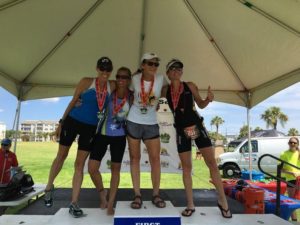
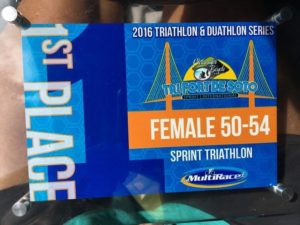
This was written by my client Laura Engleby whom just as she has detailed, took 1st in her age group in 2 of the FD3 Series Sprint Triathlons and 3rd in the last one. These accomplishments gave her 1st place for the series. She also took 4th in her second Olympic distance triathlon. She put in the work, took the prescribed suggestions and followed the plan we made for her.
I cannot even put into words how proud I am of this woman and what she has accomplished in the short amount of time I have been privileged to be coaching her.

The previous post was a review of the FD3 Triathlon Series as if it was a product. Below you will find a more detailed account of my personal experiences during the race. Let me know in the comments section if you have any feedback on which you prefer or any relevant comments.
Idina Menzel was singing “Defying Gravity” when my alarm clock announced it was 4:15 a.m. and that it was indeed time to rise. It was the first time in a while, that I wished I could hit the snooze bar on race day. Usually, I wake up with a bounce in my step, but today was a little different. Not that I was not taking it seriously. If training with Jon Noland and Tribal Multisport has taught me anything is that you do not “toe the line” if you are not going for the win.
My coaching methodology is a little different, but I have made a lot of progress with Tribal, so I have stuck with this mentality for my own training. My coaching niche is very different as well. While I train newcomers, or returning clients to the sport, Tribal trains athletes. I have learned a lot in my time with Coach Jon Noland, and I find myself a better coach and athlete the more I do.
Nevertheless, the words were echoing in my head. “If you are not going to go all out when you toe the line, then don’t.” I knew once I got out there and saw my Tribal peeps I would be ready to go.
My head cleared after taking some calories from a pre-workout drink, and inhaling my vitamin supplements. I felt more like myself, so I quickly grabbed all my gear I prepared the night before, racked my bike, and headed out.
I tend to get a kick out of driving to a race. It’s my time to contemplate my strategy and lessons learned while being surrounded by my own environment.
The YouTube soundtrack to the Rise and Shine video was blaring over my radio speakers as I approached the parking lot. The full spectrum palette of colors were being displayed before me in tri-kits, helmets, and bikes as athletes were in all stages of preparation for their own challenges.
My preparation was completed prior to my arrival, so the only thing I did was grab my backpack from the trunk, remove my bike from my rack and stroll into the check-in area.
Triathlete’s tend to always worry about their bikes, and I am no exception. I have been privy to plenty of stories of cyclists colliding head first with other cyclists, inanimate objects and people, where the first words muttered upon becoming conscience were not, “I am hurt” or “Is the other person ok?”, but the fearful question; “Is my bike alright?!” It doesn’t matter if they have a broken arm, leg or collarbone the first question is the same.
With that kind of mentality it is obvious we all tend to be security conscious about our bikes, but I have to say I do not carry that fear with me at a race venue. I tend to believe two things; 1) the event planners have adequate security and 2) there are plenty more expensive bikes than mine around.
Multirace, as always, provided one rack at the entrance to the check-in area in order to allow the athletes to rack their bikes in order to keep the congestion down. Of course, due to the aforementioned insecurities, most of the local triathletes did not utilize the racks, therefore it was ended up quite crowded when I arrived around 6am.
There was a table with two volunteers checking-in athletes and I ended up in a line with approximately 15 people, so I waited about 10 minutes to receive my bib, bike and helmet stickers. However, the swag/t-shirt, body marking and chip distribution stations were less than a minute each, so overall it was a very smooth experience.
I had already bumped into a few other athletes I knew including my own client, Laura, whom would be defending her Age Group First Place finishes she earned in the first two events in this series.
Sweat already started rolling down my arms as I rolled my bike into it’s nesting place among the other carbon fiber speed machines in the transition area. I was fairly quick to set my bike and running shoes, towel, helmet, hat, sunglasses and race belt at the front tire of my bike, when the rest of the crew started to notice I arrived.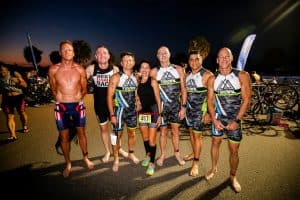
Miles and Ted, decked out in the same Tribal camouflage tri-kit, found me and as we started socializing, Rick, Laura, Nick and Coach Jon had also joined in just as a photographer was strolling by. We didn’t let that opportunity go to waste..
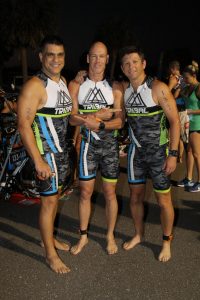 Pre-Race
Pre-RaceAs we chatted on our way to the beach, the beginning of my race anxiety started to creep into my stomach. No matter how many races I do, no matter how densely populated the field is, the nerves always pop up right before showtime. The only difference is, I know to expect it now.
I jumped in the 83 degree Gulf of Mexico, to warm up and get a feel for the water. It was unusually calm with a low tide which would make the swim fast, but would also allow for some of the less experienced swimmers to walk over the shallow sand bar in the beginning and the end of the swim course. Sometimes, it could make it hard to swim around them. It is one thing to pass, or swim around another swimmer, but a walker is a like an immovable object.
The swim is not my strongest portion of triathlon, but I have really been putting an effort in to become more efficient. Three years ago, I would probably be one of the athletes overjoyed to have places in an 800-meter swim to be able to walk for a bit, but I have realized through my training, and as a coach, it is not efficient and could be detriment.
Running or walking in the water utilizes a great amount of quad and hamstring strength of which is needed more on the bike and run. While, some of the other athletes, including myself, might actually be faster running in the water, it would likely cause a slower bike and run split, therefore not very cost effective.
I turned back toward shore just as one of the volunteers started corralling us out of the water in order to start the festivities. The nerves were still there, but much less intense. Having the opportunity to be enveloped by the water, and feel the grade of tension on my forearm as it pulls through the water always calms me down prior to a start of a race. That feeling is a reminder to my psyche that says, “Yo…Brad…this is nothing you haven’t done a thousand times before, either in training or a race.”
Our Aussie announcer, gave his last instructions on the swim course, the first wave lined up and the triumphant siren of the air horn went off. First, was the open wave, then the under 40 age groups, and at 7:07 am that same horn saturated our ears to send me and the 40 and over age group out into the salty current.
Running out in to the surf was not as easy as jumping into the pool. Low tide kept the water even more shallow than usual, so duck running was all we could do until it was deep enough to dolphin dive and then finally start a good freestyle stroke.
I was able to swim to the first buoy pretty fast and it was smooth sailing from there. I have been working on a long reach with a two-beat kick then driving the hip down as I pull through. I will say it is probably the most efficient technique where I can stay relaxed, but it is far from fast.
During this race, I was surprised as I approached the second buoy and reached to find another foot there. My inner 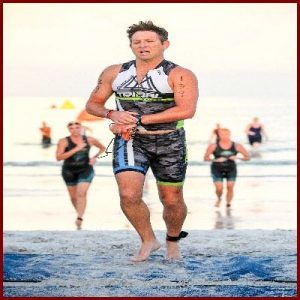 dialogue reacted with “What? I caught someone?”. I moved to the left and passed him. I continued swimming and reached and hit someone thigh. Now this was getting a little crazy. I don’t pass people on the swim, they pass me.
dialogue reacted with “What? I caught someone?”. I moved to the left and passed him. I continued swimming and reached and hit someone thigh. Now this was getting a little crazy. I don’t pass people on the swim, they pass me.
At the final buoy prior to turning to the beach, everything seemed to come to a halt, as people started walking because it was shallow. For a few steps I did the same just to get around some people, but I felt so good I actually wanted to swim. When I found clean water, I continued swimming towards the finish.
My goal was to cross the mat at 15 minutes flat. I came out of the water, crossed the mat and hit the button on my watch as it glowed 15:10. An audible, “Wow, I’ll take it.” came out of my mouth after recognizing how close to my goal. Last month at the FD3 #2, I walked out over 17 minutes, so I was pretty happy at that point.
I must have conquered my efficiency goals, because I had a ton energy to run into T1. Of course I passed my bike and had to double back, but that was only a few seconds. I put on my helmet as I slipped my bike shoes on and slid my bike back and under the bar as I headed to the mount line. I clicked my watch as I crossed the mat at 2:59. A different oral comment came blurting out which was a little negative compared to the first one since my goal was 2:30.
The ride started like a rocket. I was able to pick up speed fast and reach goal power within a few seconds of turning onto the main road. The course would be two loops around Fort DeSoto Park.
Last month, I just wanted a strong bike, and I went out completely on feel. This time I wanted to stay at between 85 and 90% of my FTP (Functional Threshold Power). FTP is the maximum power in watts that can be held for 1 hour, in my terms, from fresh to dead. Currently mine is calculated at 225, so I wanted to stay in-between 191-202 watts.
The wind is usually pretty intense at Ft. Desoto, but we were lucky the last two races of the series. The wind was mild for the previous race and at this point I could feel the cool air against my tri-kit causing that goosebumps sensation, but still not as intense as the last few training rides I participated in here.
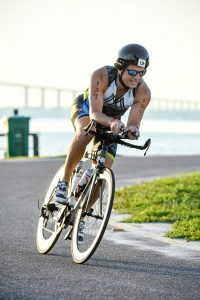 I started passing people down my right side without any challengers coming behind me until I the roundabout, marking the end of the first loop, came into view. At that point the phrase “Good Job Brad, keep it up” came from a passing rider, crystal clear as if he was walking next to me. That rider was my coach, Jon Noland, screaming by on hit BMC Time Trial bike.
I started passing people down my right side without any challengers coming behind me until I the roundabout, marking the end of the first loop, came into view. At that point the phrase “Good Job Brad, keep it up” came from a passing rider, crystal clear as if he was walking next to me. That rider was my coach, Jon Noland, screaming by on hit BMC Time Trial bike.
I kind of expected it. Jon was competing in the Sprint Distance, so he started about 10 minutes behind me and as he swims much faster , and he bikes at around 25 mph versus my speed of around 22, it was only a matter of time, but I was happy to have held him off for almost my first, and his only loop.
The second loop felt a little tougher, but the miles clicked by and I stuck to my game plan. I continued to pass riders, but I did get caught by one and I used him the last five miles as a motivator to push a touch harder.
As the dismount line came closer I loosened the straps of my bike shoes and started to slip my feet out. At the line, I left my shoes in the clips, dismounted and ran to my transition space. I hit the button on my watch as I crossed the mat, but didn’t look at the time, but it ended up 54:35 while my goal was to be under 55 minutes.
Again, I heard the sound of Jon telling me “Relax Brad. Smooth is fast” as I departed transition in 1:03 where my goal was 1:10. It was probably pretty clear my astonishment as “Yeah Baby!” came spitting out of my mouth as I crossed the timing mat.
My thoughts ventured to the last FD3 race. It was extremely hot and I ended up doing a little more walking then I wanted to, so this time even though I had a time goal, my inner monologue was telling me to just keep running. “If you keep running the time will take care of itself.”
The first mile is all on hard packed sand, which was even harder due to the rain experienced the night before. This made 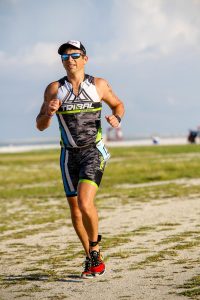 it a little easier to navigate, but the sun was really beating down, and the temperature was starting to rise. As I rounded the corner toward the asphalt path, my watch vibrated and chirped at the first mile. I looked and was happy to have run under a 9 minute mile which lined up with my goal o 55 minutes or under.
it a little easier to navigate, but the sun was really beating down, and the temperature was starting to rise. As I rounded the corner toward the asphalt path, my watch vibrated and chirped at the first mile. I looked and was happy to have run under a 9 minute mile which lined up with my goal o 55 minutes or under.
The first aid station, held out Hammer Heed, and water, which both were deliciously ice cold. I grabbed one of each, downed them and kept running.
My legs started to get heavy, but I knew it was more because I needed three miles for my legs to transition and gain my rhythm. At the 1.5 mile aid station I grabbed 2 cups of water which I downed one and poured the other down my back. That felt so good, as the water was still ice cold.
The turnaround brought me back to that aid station where I grabbed one more cup and doused myself. I could feel the sun heat my skin to an uncomfortable level. The sweat was starting to creep into my eyes, and the suffering started.
I ended up slowing down a bit, but I kept running. As I was passing the finish line in order to start my second loop, I could hear my friend Josh, yelling for me to get going as I walked through the water stop there to pick up some hydration. It was only a few seconds before I restarted on the beach path toward the fourth mile marker.
The second loop was more like the first, which was surprising. I expected to feel like I needed to slow down more, but I didn’t. I had more in me than I thought. When I passed the 5 mile sign, I was relieved, but felt like I even had more to give. I picked up the pace a bit in anticipation of the finish line and then I decided to progressively get faster as that last mile clicked on.
I looked at my watch, thinking 1.2 miles to go, then before I knew it I only had 0.7 to go, then 0.5 and when I could see the finish line, I picked it up. The only thing running through my head was Finish Strong, and the faster I get to the finish, the faster I am done.
I crossed the finish line and realized I was completely spent.
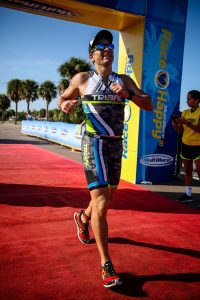
One volunteer gave me a medal, while another detached my timing chip from my ankle, and a third handed me a cold bottle of water.
As I stumbled to the back of the finish section, my client Laura found me. I asked how she did, and disappointingly she told me that she placed third. I was overjoyed, but she didn’t feel the same.
It was noticeable that this race was more populated than the last race, so I knew she would have more competition then the prior races. I asked about her time, and she told me she hadn’t looked yet, so I grabbed her by the arm and pulled her toward the timing table. The volunteers took our bib numbers and gave back slips with our times on them.
Laura PR’d again, and wouldn’t you know it, so did I, by 6 minutes. I couldn’t believe it.
I ended up finishing the run in 55:04 which was pretty much my goal time, and a final time of 2:08:47. That time put me in 8th place in my age group, which I was happy to be in the top 10. I wasn’t going to be standing on the podium, but I was happy with my performance and my PR.
I am not the fastest, but I continually strive to do better than I did the last time. In July I PR’d this race by over 15 minutes and in a month I PR’d again by another 6 minutes. While I did have time goals, of which I was a little off of, I did what I came out to do.
The best part was Laura and my Tribal buddies had a stellar day. Yelena picked up her second Female Over-all win. My former client and Tribal buddy Josh, picked up his Age Group win. Rick won the Masters division. Miles ended up with a 2nd place AG, and of course Jon again took the Overall win in the Sprint.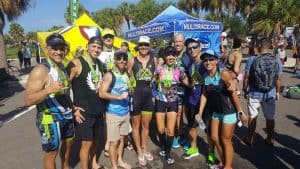
We did find out that since Laura took 1st in the first two races of the series and 3rd in the last, she won 1st place in her age group for the series. That was very cool and I am so proud of her for that accomplishment.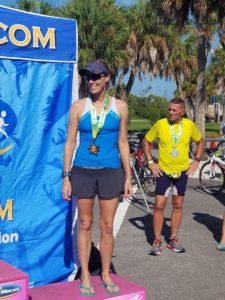
The rest of the time consisted of socializing, and eating as usual.
The experience of this race was stellar. I highly recommend it to anyone who enjoys the Sprint or the International Distance triathlons. Just be prepared for the climate and the possibility of a windy bike and challenging swim.
What did you think of this format of a race review versus my first post? Do you have a favorite race that could be enjoyed by other triathletes or duathletes?
I would really appreciate your feedback in the comments below.
Carpe Vitam! (Seize Life!)
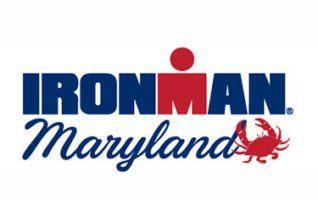
I signed up for Ironman Maryland initially due to the reviews that said it was fast, and beautiful. Jaime started it with all the hype about it being a fast flat bike course because she despises hills, even though most of her fastest bike splits came on hilly courses. Touché. So, last year after a lot of pestering Pete, we registered and the training began. Pete, Jaime and I have been training together for about 4 years, ever since I decided to get serious about triathlon. We ingeniously started calling ourselves “PB&J”. Get it? Peanut Butter and Jelly or Pete, Brad & Jaime.
Interesting enough though, I really wanted a sub 12-hour Ironman and Jaime was shooting for a sub-13, so as much as we enjoy training together we actually ended up going our own ways. I started training at Tribal Multisport with Coach Jon Noland, and Jaime trained with Personal trainer and elite athlete Kenneth Jones.
We made all the arrangements well in advance. We had hotel reservations at the host hotel, restaurant reservations, tri-bike transport was scheduled, flights were booked and cars were rented well in advance.
We talked constantly throughout the months, confirming our plans, comparing training schedules and every once in a while, we actually did get together to train. PB&J looked strong and ready to face IRONMAN Maryland together. Unfortunately, in September, Pete ended up injuring his Achilles’ tendon and after a lot of conjecture decided it wasn’t in the cards for him this year. I told him, it would better to live and race another day than to permanently hurt himself.
We departed for the race on Wednesday, September 30 completely anxious and excited. We headed to Tampa International Airport, for an uneventful flight into Baltimore-Washington Airport. Within a half hour we were in our Jeep Compass rental and headed up Rte 50 in Maryland.
We stopped for a quick lunch at Carmine’s Pizza to carb load with pizza and salad and just as we are about to pull out of our parking space and back into traffic, Jamie’s phone rings. Ed, a friend and first time Ironman athlete, called and tells us the race has been cancelled. I could hear Jamie’s voice say, “Uh say that again…wait…wait. Let me put you on speaker.” A deep Jersey accent comes from her speaker and says “They cancelled the race.” Really? This early.
The last time WTC cancelled a race it was in Lake Tahoe and the athletes were in their wetsuits ready to jump in. They waited that long and now, 3 days before the race they were cancelling it.
We jumped on Facebook, and the IRONMAN Maryland site and were met with the validation that WTC had indeed cancelled the race. It turned out the immediate threat from Hurricane Joaquin was dire and it was in their best interest to keep the athletes, volunteers, race staff and spectators safe. Not to mention, there was already four inches of water already on the course.
We got somewhat lucky. We were able to find a flight home that night, and the hotel did not charge us a night for cancelling so late. Unfortunately, the flight back cost us just as much as the full round trip, and because we pre-paid the car we couldn’t get that back.
WTC anticipated rescheduling but couldn’t give the athletes a final decision until the following Tuesday. The wait was hard. What do you do? Do you keep tapering? Do call it a season? There was nothing to do but wait.
Late Monday night an email hit my account stating that the race was back on and it would be held on October 17th as predicted. All I can think of was “Here we go again.” What if the weather was bad again? Would we spend even more money just to go through another disappointment?
Coach Jon, put a schedule together of low duration, high intensity workouts to keep my body from degrading fitness for the next week, and I managed to squeeze out a 17 mile run with a client that felt awesome the Sunday prior. The weather outlook was good, cold, but decent. As the days passed, the forecast kept getting colder and windier, but no precipitation was even close.
This time it was going to happen.
From Tuesday on, Jamie, myself and another training partner of hers, Hunter, had a group text as we kept planning our trip. We found decent round-trip flights, Hunter found a rental house, and I again reserved a car. Of course this time I bought the trip insurance as well, which, of course, I did not need.

The View from our DC Hotel
And on October 14th, we took off for the second time from Tampa and arrived, this time at National Airport in DC. We spent a great night at the Residence Inn in Pentagon City before heading out to Cambridge the next day.
As I drove though the rural part of Cambridge and into the long drive way of our rental home, I was surprisingly calm. Subconsciously, I think I just didn’t want to get my hopes up, but my heart rate did jump at the surprise I felt pulling into the gravel drive way. It was gorgeous!
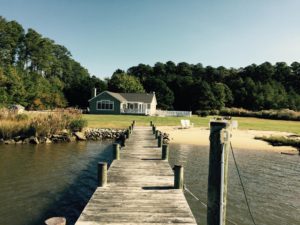
Our Cambridge Ironman HQ
There stood a modest one-story ranch home, but on a huge amount of acreage that backed up to a lake. It had it’s own dock, fire pit, pool, and a beautiful deck. Inside it was an open floor plan with a dining-kitchen area, huge great room and three good size bedrooms. It was decorated modestly, with wood floors and a kind of rural, yet updated and upscale charm to it. All of the appliances were current models in the kitchen and baths with flat screens in each room, and a large one, in the great room, a fireplace and gigantic sectional couch that all of us could have slept on.
What was even luckier was that it wasn’t only Hunter, Jamie and myself, but Kenneth and his parents, so by sharing it, the cost was not even half of what we would have to pay for the hotel.
I also have to say, that Ken’s parents, treated all of us like we were their kids. His Mom, Lucy, cooked and cleaned for us, and his Dad, Phil, grilled, shopped and chauffeured us around to make sure we were at the right place at the right time. It was like Ken, outsourced his parents to us. Of course that wasn’t the case. It seemed like they genuinely loved doing it.
It came time to travel over to transition and pick up our bikes, and then head to Ironman Village to check-in.
We reached transition and since Hunter and Ken already had their bikes, because Ken and his parents drove them up, they headed out to check out the swim start while Jamie and I talked to Tri-bike transport. Jamie’s bike was already in the rack, but unfortunately, mine was not to be found. My stomach took a little turn when Drew, from TBT, said I wasn’t on the list to have my bike at the race.
Luckily, he said that my bike was in the truck, but it was with the bikes that were sectioned off for the athletes that were not going to be returning.
I headed over to the transition area to scope it out and then took a quick peek at the swim start and at that point, my anxiety started to increase. This was happening. There no “ands”, “ifs or “buts”. I was going to be racing my third Ironman.

Ironman village was exactly as it was for every other Ironman and Ironman 70.3 I have raced except, because they were not able to keep all of the original volunteers procured, it was a lot slower checking in. We waited in line for close to two hours before we finally made it under the tent to pick up our packets and swag.
When we finally got through that line, we contemplated going into the Ironman store, but the line to check-out was just as long and we still wanted to get a quick workout in. In every Ironman store I have been in, for every race, the cashiers, (bless their hearts) are always so slow that you know if you do get in that line, it is going to be a lot of time.
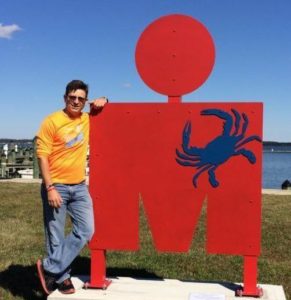
We headed back, and unfortunately, I had yet to receive a call from Drew to tell me that he was able to dig out my bike, so the others headed out on their bikes and I decided I would just work a little while I waited for his call. At 4pm, I did receive the call and 45 minutes later I was back at the house with my bike.
Leading up to the Saturday morning, was pretty much the same as any other long race. Putting gear bags together, going over transition and nutrition plans, and quick workouts in all three events. These were basically just to make sure everything was in working order.

The Goof, Ken, Hunter, Jaime & Ed before a swim workout
Did I mention Thursday night we had a campfire and made s’mores? Yeah, we did that too.
I was pretty shocked at how well I slept Friday night. We had all turned in quite early, in anticipation of not being able to sleep, but I drifted off pretty fast and slept until the 4:00am alarm woke me up. None of us were in a rush as we all felt pretty prepared, and the outside temperature was only in the upper 30s. I dressed, ate and leisurely grabbed my morning bag and we headed out into the darkness.
Leaving the house I had yet to really feel nervous, but as soon as we pulled up to transition, I felt a pressure in my chest. My heart started to beat so hard, I thought it was going to crack through my rib cage and take off on me.
I looked over at Jamie, and she looked back and said,”Sh*t just got real.”
After outfitting my bike with my nutrition and helmet, I took a walk over to the actual swim start line and looked over the water. Waves didn’t seem that bad, but the water was far from calm. I could feel the wind on my skin even through the wetsuit. Luckily, while it was 38 degrees outside, but the water it was 63. That was going to work in our favor, as it was actually going to feel warmer in the water.
Around 6:40, Jamie, Hunter, Ed and I were all hanging out trying to keep warm and maintain a positive mental attitude, when the speaker echoed our announcer’s voice. The safety team had stated that the winds were causing a lot of churning in the water, so the boats and paddle boards could not take their places on the course. The solution was to shorten the course to 1.2 miles.
I should have been really excited about this, as the swim is my weakest event, but I wasn’t. I was actually a little upset not only because I wanted to prove to myself I could get out of the water within my goal, but also for Ed and Hunter as this was their first full distance Ironman.
What else could happen? First they postpone the race, and now they shorten the course. This race just seemed cursed.
That was not the end of the story. Around 7:10, an announcement was made that, the winds had died just a little and would be enough to get most of the swim in. We would do the swim, but we would be about 800 meters short.
Things just looked better. I felt redeemed and a positive relief flowed through me for about half a second. I still had to get passed the swim. If you remember from my post about my last Ironman, I was the last one out of the water to be able to cross the line. I worked a lot harder on my swim this training cycle, now I would have to prove it.
At 7:30 we lined up according to how much time we thought it would take us to swim the full 2.4 miles. I lined up at the behind the 1:30 sign and after waiting another 20 minutes to get through the line, it was my turn to jump in.
The water still frigid enough to shock my body a little, but my adrenaline kept me warm. I immediately headed to the first buoy where we would turn right and then head in triangular pattern.
I felt really good during the first lap. For the first time in an Ironman race I was actually passing people and it felt amazing. I still felt pretty strong as I made the turn for the second lap, but I did slow down a bit.
As much as I thought I loved my long sleeve wet suit, I didn’t have the mobility in my arms, that I developed during training, and I had to strain to lift my arm into a streamline position. I listened to myself hypothesize about it and I thought, “Am I really thinking this? Did I really become a decent enough swimmer to even contemplate it?”
On the second lap, the wind picked up again and I thought I was swimming in my washing machine. I got tossed around and the effort level increased. I did end up breast stroking intermittently for a few minutes to catch my breath and realign my siting, but I continued. My habit of zig zagging didn’t show up until the last straight away while I was trying to sight on the finish. The waves were pushing me in the wrong direction, but my sighting was able to put me back on a good path. I jumped out of the water and ran towards the timing mats, and as I crossed I looked down at my watch – 1:10.
1:10? Really? I had to double check it twice. If I added the 800 meters back on I would have finished around 1:25-1:30 which, was my goal.
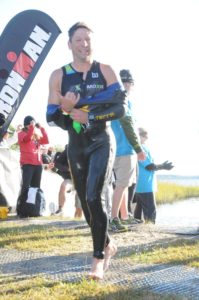
I was so excited I sprinted to the strippers, but for some reason they didn’t help. My wet suit would just not come off of me and when it did, oh man, did I feel the weather. The wind hit me, and my soaked tri kit, like a brick wall.
I headed into the changing tent and dawned a bike kit, arm warmers, a gator neck, and gloves. By the time I added my helmet I looked like a Tri Ninja.

Ed gave us a quick rundown of the bike course the night before, as he came up earlier in the year and actually trained on it. He explained how the course was an oval and we would probably have a head wind on one of the shorter sides and away or back to transition. This would account for two blocks of 12 miles since we had two laps. I was ok with it. I would just turtle for those 24 miles. (This is a technique keeping your head down and allowing your back to come up like a turtle shell to be as aerodynamic as possible.) The rest of it my plan was to stick to 75-80% of my functional threshold power(FTP) as possible. In training that proved to be right around 20 miles per hour which should get me back to transition in 5:35, and then taking account for the wind, sub 6 hours.
No such luck. I have never ever been on a bike course where the majority of the turns were to the right, and kept being hit by the shear force of a 33 mph head wind.
I wish that were the only factor that slowed me down.
I knew because of the temperature that I would not want to drink, but due to the fact my calories were mostly in my bottles, I would have to. What I didn’t count on was that I would have to stop at a portlet every 10-15 miles to urinate. I am just not die-hard enough to urinate while I am on the bike, and we were specifically told that if athletes were caught relieving ourselves outside of designated facilities they would be DQed. That slowed me down.
From mile 40 to 50 we were all riding on the shoulder of the road, into the wind. Directly to the right of the white line were slowing rickets with very small spaces in between them. They seemed a little dangerous, so everyone was either on the right of them, or on the left and swerving to the right when traffic would come from behind.
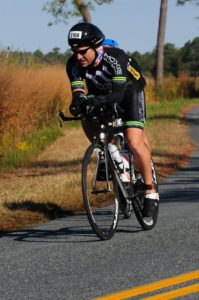
I was in aero, with my head down, when I saw a tire in front of me, so I yelled “On your left.” The wind was so loud the person in front of me, wearing a “This Guy Needs A Beer” jersey, could not hear me. As I slowed down to keep enough bike lengths between us to satisfy the drafting rule, I noticed a motorcycle next to me. It was an official.
He pulls out a memo pad and yells to me, “At the next penalty box, tell them you have blue card.” Well, I wasn’t going to start arguing while I was the bike, so I nodded.
At the mile 56 aid station there was a penalty box, so like a good athlete I did what I was told, and so did the other seven athletes that came in behind me. There we all were. Eight, age group, athletes standing stretching while we waited for our five minutes to be up. I am all for rules, order and safety , but it’s a little ridiculous when there are eight people in the penalty box all caught doing the same thing on the same stretch of road. As this was my 3.4 hour mark on the bike, I asked the volunteer who had to time the penalties how many he had so far. He kind of smirked and said it had to be over one hundred.
At that point I just had to laugh. I got back on my bike and continued trudging through the wind.
Ten miles later, a slow burn started aching my legs. I didn’t understand it. My cadence was up, but no matter how high I shifted, I felt like my effort level was increasing. Then I heard what was a metal grinding. Yep, you guessed it. A flat in my rear tire. These were brand new tubular tires, I had installed just for the race, and now I punctured them. I had a bottle of pit stop in my jersey, so it was only a couple of minutes before I was back on my bike. With Pit Stop, I didn’t even have to take the tire off, just empty the contents of the bottle into the tire and go.
Luckily, I didn’t have to stop nearly as much the second loop as I did the first to urinate, so I picked up a little bit of time, but while keeping to my FTP goals, I could barely get above 17 mph. It felt slow and torturous.
The left turn for the last 12 miles came and I thought maybe we would catch a break and as I passed the last aid station one of the volunteers yelled, “Your on your way back, no more wind!”
He lied.
The whole way back to transition, the wind hit us and kept our pace to a slow 16-17 mph.

As I dismounted my bike, I could feel not feel my toes or my hands, and I was just frigid. I tried to take off my bike gear, and it was extremely difficult. I felt like I did, during the last ironman at mile 13 of the run and I hadn’t even started the run yet.
The grumbles in the changing tent were all the same. The bike was windy, it was tough and it sucked, but it was over. A few of the guys who competed in last year’s event said they were over an hour slower than the previous year. That actually made me feel a little better.
I have a saying I give to my athletes when they start to walk or I find them giving up on themselves. “The mind will quit 100 times before the body does.”
For a nanosecond a thought went through my head. “I already did two of these, I don’t need to prove anything to anybody. Forget this.” Then the next nanosecond went by with my inner dialogue that said “Who are you kidding Minus? You know you are going to finish if you have to crawl across that finish line. You never quit anything in your life, what makes you think your going to do it now?” The last words that echoed in my voice were that of my coach Jon Noland. “Embrace the Suck.”
I changed the best I could with numb fingers and toes and started the run. (I found out later I spent over 20 minutes in T2. It sure didn’t feel that long. I must have taken a nap.)
The first two miles felt a little slow, then at mile three it was like the pearly gates opened up. My legs transitioned into a good running form and I took off. I felt amazing.
I kept to my strategy of walking through the water stops, which during an Ironman is every mile, but they are only a few yards long, unlike those at a major marathon, where the distance could exceed a hundred yards.
At mile seven I actually felt a side stitch which hasn’t happened in a race in years. Luckily, I still had my wits about me. What is the cause, or better yet, what is absent from my body that would possibly cause a stitch? Potassium. Wouldn’t you know it but an aid station was just fifty meters ahead of me, so I grabbed a banana. Within the next quarter mile, the stitch was gone, so I picked up speed again.
The course was two-and-a-half loops that took us from transition through a residential neighborhood, around a park, back through the neighborhood passed transition, into downtown Cambridge where it either started again, or headed to Ironman Village and Finish line.
We had been told that Cambridge was supportive of the race and even in these cold temperatures, the town was out in droves.
Along the route there were kids on their lawns cheering, a dancing banana, residents on lawn chairs, and local bands playing outside their homes. While running through downtown people were outside the bars drinking and cheering every athlete on as they passed. It was just spectacular.
I found Jamie ahead of me around mile 5 and we ended up passing each other three more times. Each time I was getting closer and closer to her. I had hoped to get closer, but in the end she did end up crossing about three minutes ahead of me.
I never ran over 90% of the run during an Ironman before. This time the only time I walked was through water stops and only stopped twice to use the portlet. Granted it was not extremely fast, but it was still over twenty minutes faster than my best Ironman.
My legs at mile twenty were very heavy and this was the half lap and the last time I would have to turn left after downtown Cambridge. I kept going, and didn’t stop but it was getting quite dark to a point where there was a portion of road where I couldn’t see my hand in front of my face. I just kept going.
The thing I just kept thinking in my head was one day, I would finish an Ironman and it would still be daylight.
I came out of downtown Cambridge and made the right towards the chute. I heard the announcer call my name and as I saw the arch of the finish, I wondered if I had it in me.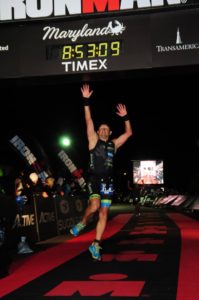
I ran just a little faster and jumped up, caught a little air and touched the arch. I was an Ironman. Again.
My finishing time was 13:08:53 which was actually and hour and forty-six minutes faster than my best Ironman, but if I kept the same pace on the swim, I calculated I would probably have crossed about 20 minutes later which would have given me a ninety minute personal record. In those conditions, I‘ll take it.
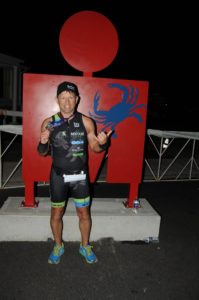
Of course I did not do this alone. I have to thank my coach, Jon Noland for training me (coaches need coaches too), the athletes at Tribal Multisport for pushing me further than I thought possible, the Moxie Multisport team for the help with gear, nutrition, and the support to keep me going through the long training period, my travel and housemates, Jamie, Hunter, and Ken for the great time at the house, and for keeping me sane and laughing, Ken’s parents, Phil & Lucy for the race weekend support, and last but never least, Kim for supporting me at home through this third Ironman.
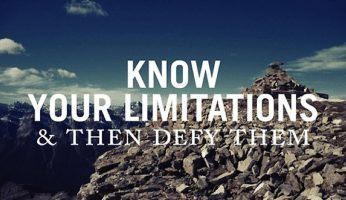
On Tuesdays and/or Thursdays, I will do my best to give one simple fitness, triathlon or running tip, trick or piece of information that will provide some value to in either helping you to become more efficient, prevent injury, increase performance, have more fun or at the minimum give a review of knowledge that might not have crossed your path in a some time.
I find myself observing other runners while running and sometimes just hanging out here in Tampa. Due to the weather here lending itself to year-round training, I have no shortage of material to choose from.
My coaching practice’s number one priority is form, technique and injury prevention, so I routinely use other runners, with my clients to reinforce the form training I have provided. (Sorry, Tampa runners. If you happen to pass by me with a client, most likely you have been observed and surveyed for comparative analysis.)
With all of my observations, the number one issue that I see are runners that sit in the bucket. Of course, the question most people ask is what does sitting in the bucket mean?
Basically, it’s when the glutes(or bum) are not in line with the torso. The body looks like an “L” from the torso to the hamstrings. Natural running which when learned is much easier, more efficient and greatly reduces impact on the joints. The torso hips, glutes and ankles form a straight line.
[table “2” not found /]
The interesting thing is, that running should be instinctual right? Unfortunately, not anymore. Sociological factors have played into our bodies to a point where most Americans, cannot just decide to take up running without going through periods of injury.
For example, sitting at a desk all day will tighten the hip flexors so that it becomes extremely difficult to push the hips under the torso. The same thing is evident for playing video games on the couch for long periods of time.
The figure on the left is actually still a lot better than I have noticed out and about. The torso is still tall and the chest is still has a little bit of lean to it causing forward motion. A lot of runners I notice, sit in the bucket and lean back. What is this doing? Basically, gravity is working against the runner. The objective is forward motion but the glutes and the torso are sitting back, so in essence, the body and gravity are working against itself.
Another perception you will see is the heel strike of the runner. When that heel strikes the ground the impact reverberates all the way from the ankle through the legs, spine, neck shoulders and head. This is where most of the injuries take place.
By simply starting to incorporate, tilting the hips under the torso and leaning from the ankles instead of the waste, the body will start allowing gravity to be used instead of the legs as the sole source of momentum. Suddenly, the feet are striking the ground underneath the center of gravity and only the calf down to the metatarsals absorb the majority of the impact from the ground.
I continue to instill in my clients, running is powered by the core, not the legs. Use gravity as momentum and allow the legs to just go for the ride. To remain consistent, the core must be strengthened and hip flexors stretched to keep the glutes from returning to the bucket.
There are many techniques to help modify the behavior to allow for an efficient, safe and effective change of form. All it takes it the will to want to change and get better and you will.
The #1 tip – get out of the bucket.
Are you running in the bucket?
Did this information shed some light on any area of your running that might be in need of improvement?
Carpe Vitam!
(Seize Life!)